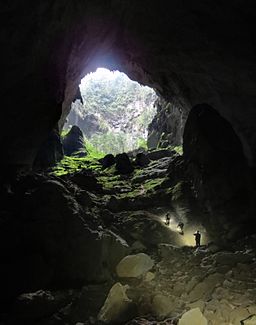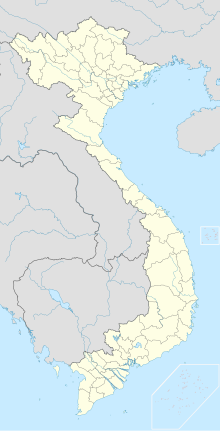Hang Sơn Đoòng
| Hang Sơn Đoòng | |
|---|---|
| Sơn Đoòng Cave | |

View approaching the second doline
|
|
| Location | Quảng Bình Province, Vietnam |
| Coordinates | 17°27′25″N 106°17′15″E / 17.45694°N 106.28750°ECoordinates: 17°27′25″N 106°17′15″E / 17.45694°N 106.28750°E |
| Depth | Max 150m / 490ft |
| Length | Approx 9,000 m / 30,000 ft |
| Discovery | 1991 [AD] by Hồ-Khanh |
| Geology | Permo-Carboniferous limestone |
| Entrances | Approx 2 |
| Hazards | Underground river |
| Cave survey | 2009, British/Vietnamese |
Sơn Đoòng Cave (Vietnamese: Hang Sơn Đoòng ([haːŋ˧ ʂəːn˧ ɗɔ̤ŋ˨˩]); 'cave of the mountain river' or 'mountain cave of Đoòng [village]' in Vietnamese), is a solutional cave in Phong Nha-Kẻ Bàng National Park, Bố Trạch District, Quảng Bình Province, Vietnam. As of 2009[update] it has the largest known cave passage cross-section in the world, and is located near the Laos–Vietnam border. Inside is a large, fast-flowing subterranean river. It was formed in Carboniferous/Permian limestone.
Hang Sơn Đoòng was found by a local man named Hồ Khanh in 1991. The whistling sound of wind and roar of a rushing stream in the cave heard through the entrance as well as the steep descent prevented the local people from entering the cave. Only in 2009 did the cave become internationally known after a group of cavers from the British Cave Research Association conducted a survey in Phong Nha-Kẻ Bàng from 10 to 14 April 2009. Their progress was stopped by a large, 60-metre (200 ft) high calcite wall, which was named the Great Wall of Vietnam. It was traversed in 2010 when the group reached the end of the cave passage.
According to the Limberts, the main Sơn Đoòng cave passage is the largest known cave passage in the world by volume – 38.4×106 cubic metres (1.36×109 cu ft). It is more than 5 kilometres (3.1 mi) long, 200 metres (660 ft) high and 150 metres (490 ft) wide. Its cross-section is believed to be twice that of the next largest passage, in Deer Cave, Malaysia. The cave runs for approximately 9 kilometres (5.6 mi) and is punctuated by 2 large dolines, which are areas where the ceiling of the cave has collapsed. The dolines allow sunlight to enter sections of the cave which has resulted in the growth of trees as well as other vegetation.
...
Wikipedia

